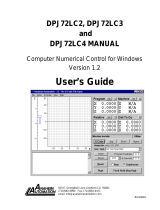
Self-teaching manual
·MC· Option
REF. 1010
3
INDEX
CHAPTER 1 THEORY ON CNC MACHINES.
1.1 Machine axes. ........................................................................................................... 7
1.2 Machine reference zero and part zero....................................................................... 9
1.3 Home search. .......................................................................................................... 10
1.4 Travel limits. ............................................................................................................ 11
1.5 Setting the part zero. ............................................................................................... 12
1.6 Work units................................................................................................................ 13
CHAPTER 2 THEORY ON TOOLS.
2.1 The tool change....................................................................................................... 17
2.2 The tool table........................................................................................................... 18
2.3 Tool calibration. ....................................................................................................... 20
CHAPTER 3 MANUAL PRACTICE.
3.1 Description of the screen and the keyboard. ........................................................... 25
3.1.1 Keyboard description. .......................................................................................... 26
3.1.2 Description of the standard screen. ..................................................................... 28
3.1.3 Description of the auxiliary screen....................................................................... 29
3.2 Home search. .......................................................................................................... 30
3.3 Spindle..................................................................................................................... 31
3.3.1 Speed ranges (gears). ......................................................................................... 32
3.4 Jogging the axes. .................................................................................................... 33
3.4.1 Handwheels. ........................................................................................................ 34
3.4.2 Jogging. ............................................................................................................... 35
3.4.3 Moving an axis to a coordinate. ........................................................................... 36
3.5 Tool change............................................................................................................. 37
3.5.1 Tool change position............................................................................................ 38
3.5.2 Tool calibration. ................................................................................................... 39
3.5.3 How to change any data of the tool table. ........................................................... 42
3.5.4 Checking for proper calibration............................................................................ 43
CHAPTER 4 OPERATIONS OR CYCLES.
4.1 Description of the screen and the keyboard. ........................................................... 47
4.2 Work modes. ........................................................................................................... 49
4.3 Operations or cycles................................................................................................ 50
4.3.1 Editing an operation or cycle. .............................................................................. 51
4.3.2 Simulating an operation or cycle.......................................................................... 54
4.3.3 Executing an operation or cycle........................................................................... 60
CHAPTER 5 SUMMARY OF WORK CYCLES.
5.1 Profile milling operation. .......................................................................................... 65
5.2 Surface milling and slot milling operation. ............................................................... 66
5.3 Pocket cycle with a profile ....................................................................................... 67
5.4 Rectangular and circular boss cycles. ..................................................................... 68
5.5 Rectangular and circular pocket cycles. .................................................................. 69
5.6 Positioning. .............................................................................................................. 71
5.7 Boring operation. ..................................................................................................... 72
5.8 Reaming operation. ................................................................................................. 73
5.9 Tapping operation.................................................................................................... 74
5.10 Drilling and center punching operation. ................................................................... 75
5.11 Multiple positioning in several locations. ................................................................. 77
5.12 Multiple positioning in a straight line........................................................................ 78
5.13 Multiple positioning in an arc. .................................................................................. 79
5.14 Multiple positioning in a rectangular pattern. ........................................................... 80
5.15 Multiple positioning in a grid pattern. ....................................................................... 81
5.16 Profile editor. ........................................................................................................... 82




















